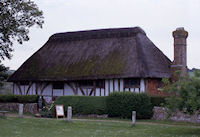
Figure 15: Alfriston Clergy House
The Alfriston Clergy House, Sussex (NGR TQ 52133 02856) is a 14th-century half-Wealden house (Fig. 15). It comprises a hall with service rooms to the west and private rooms to the east; a narrow 'lean-to' along the length of the back of the building was added in the mid-18th century. The house was probably constructed by a private individual, but had come to be used by the church for the vicar of the nearby St Andrew's Parish Church. The building has been altered over the years for private use. Alfriston Clergy House is Grade II* listed. This was the first building acquired by the National Trust, in 1894.
The Clergy House ceased to be used by the church in the early 19th century, and was divided into cottages in the mid-19th century. It had been approved for demolition by the bishop in 1879 and was saved only by the efforts of the vicar, F.W. Benyon, who alerted the Society for the Protection of Ancient Buildings (SPAB) to the house. Benyon started, around 1892, to raise money for the house (Anon 1892). In the first half of the 1890s 'some works' were undertaken, probably commissioned by the SPAB, and records of these exist because the work was not considered 'satisfactory', so an invoice was queried by the SPAB (SPAB ACH file 2).
The SPAB brought the building to the attention of the National Trust, and acted as mediator in the acquisition of the building by the National Trust, especially advising on the work to be undertaken on the building. The National Trust bought the house in 1896 for a nominal sum of £10, and undertook repairs on the building, guided by the SPAB, the National Trust describe the house as having been 'acquired with the co-operation and valuable help of the society' (Fedden 1974, 159). The conservation philosophy was agreed by the SPAB with Octavia Hill (one of the founders of the National Trust), and it was stated that they should 'restore it, in so far as that odious word means preservation from decay' (Waterson 1994, 41-2).
The building was immediately recognised as a hall house, with a standard medieval layout of hall with service rooms to one end, accessed by a pair of doors (Fig. 16), and private rooms to the other. The National Trust engaged architect Alfred Powell to 'repair' the building. Before he started work, he undertook a survey of the building (NT ACH 5). A written report and drawings recorded some of the works already undertaken, and proposed some of what was considered necessary (NT ACH 5). The works already undertaken included: removal of some of the thatch and boarding the roof; repairs to timber-framing and re-plastering at east end; replacement of roof plate to south and east elevations; and removal of the fireplace in the hall (NT ACH 1).
An estimate of £350 was then given for the works that were still required: replacement of thatch; replacement of oak rafters, posts, wall-plates, purlins etc. where required; replacement of lead-glazed windows; laying of a new stone floor; shoring old framing. Much of this work was completed and correspondence suggests it was considered successful, 'the original structure was meticulously conserved from 1896, despite lack of funds' (NT ACH 2; NT ACH 5). Notes of observations at the time recorded this work in progress:
It appeared that certain timbers had indeed been shored up and a few new ones inserted, and moreover that one end of the building had been covered with boarding, although the thatch comprising the rest of the roof had not even been touched and the rain was whipping in through great holes
(SPAB ACH 3).
These records aid understanding of the work undertaken at this time, and more can be interpreted from the building itself.
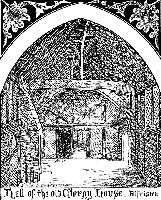
Figure 17: Drawing of the hall at Alfriston Clergy House sent by F.W. Benyon to the SPAB showing the fireplace in situ © NTPL Alfriston Clergy House. The Tye, Alfriston. 01323 870001 http://www.nationaltrust.org.uk
Architect Alfred Powell stated, when the National Trust was taking on the building in 1896, that 'a considerable amount of work still requires to be done'. Alfred Powell makes brief mention of a fireplace that had been removed from the hall, probably one shown in a drawing which F.W. Benyon included in his original correspondence with the SPAB (Fig. 17) (NT ACH 3)
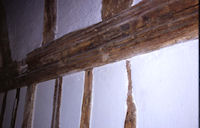
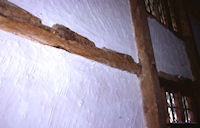
Figure 18: Moulded beam with evidence of notching to support inserted first floor in the Hall at Alfriston Clergy House
Figure 19: Notched beam where joists to support first floor would have sat
There is no mention in Powell's report or in the correspondence of the date when the inserted first floor in the hall was removed. This is evidenced in the structure (Figs. 18 and 19 show the notches where floor joists would have sat), and is very likely to have been retained and used when the building was sub-let as cottages. It seems, therefore, that it was removed in the 1890s. Such inserted first floors in medieval halls are a typical addition to historic houses, which provide physical evidence for the social changes in post-medieval society (Johnson 1993). The removal of this structural element was unlikely to have been driven by desires to preserve the structural stability of the house, but instead represents a desire, not recorded in the archives of the works, to return the building to an approximation of its medieval form.
The National Trust were proud of the medieval architectural detail in the building, and were keen to maintain the medieval features - the ogee-headed doorways, part of the original structure, are decorative and an interesting use of the available timber to create a form shallower than the norm at the time, but following the fashion as far as was possible (Fig. 15) (Martin and Martin 1993, 6). One feature which is still emphasised at the building is a chamfered beam terminating in a leaf motif (Fig. 21), which is thought to have inspired the oak-leaf logo of the National Trust.
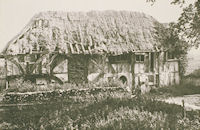
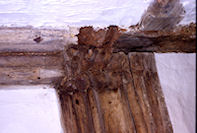
Figure 20: Alfriston Clergy House during repairs c.1896 © NTPL Alfriston Clergy House. The Tye, Alfriston. 01323 870001 http://www.nationaltrust.org.uk
Figure 21: Oak leaf carving in Hall at Alfriston Clergy House
The works completed in 1896 are recorded by Powell, who concluded that the building had been made 'in all aspects secure and weatherproof with as little alteration of its present appearance as possible and compatible with modern occupation' (NT ACH 1). There is photographic evidence of the building while work was ongoing (Fig. 20). Powell wrote that 'the restorations were carried out faithfully, without the inclusion of any fanciful or conjectural new work...the reclamation and restoration of this house at such an early date can only be commended' (NT ACH 3).
How the building would be used after the reconstruction work was complete was unresolved when the work began. In March 1896, Octavia Hill of the National Trust wrote to Thackaray Turner of the SPAB asking advice on the use of the building, proposing a caretaker's cottage and a tea room in the hall (SPAB ACH 4). Later that year, The Standard newspaper reported that:
It is intended by the National Trust to devote to village purposes the central hall of the building, noted for its massive cambered tie beams and moulded king posts
(NT ACH 4).
Through the long history of Alfriston Clergy House being open to the public since it was acquired by The National Trust, the ways in which it has been displayed and viewed have changed. Part of the building was occupied as a house until 1976, and only the hall was opened to the public. The house was refurnished in the late 1970s and 1980s with some replica furnishings and some antiques, and the majority of the building opened to the public on a more regular basis (Figs. 22 and 23). Although open for over a hundred years, this building has undergone just two reconstructions, in the 19th century and again in the late 1970s and 1980s. Figure 24 shows how this would be represented on a flowchart model, where the two phases of reconstruction are placed against the context of reconstruction work at the time.
Alfriston was reconstructed during the infancy of the conservation movement, and although the SPAB guided the work undertaken at the building, changes to its form were made that went against their principles. Recent interpretation of the house reiterates that the work of the Trust has 'restored [Alfriston] to its original form' (Anon 1998, 1).
The work planned when the building was acquired was minimal, 'I cannot see that either Architect or Building is required, since there is nothing to do but replace rotten timbers and generally repair' (SPAB ACH 3). But the reconstruction work eventually grew into an extensive project. Much of the work was guided by the SPAB, but the removal of later features directly opposed their 'anti scrape' policy of preserving many phases of a building's history (SPAB 1877; Pevsner 1976, 34-53).
Modern commentators now see as significant the choice of a timber-framed vernacular house as the National Trust's first building: Hewison describes the fact that it was built of timber, plaster and thatch as suiting the 'medievalizing' aims of the National Trust's earliest members (Hewison 1987, 56). Although the archival records for the work are patchy, it is clear from the structure that the building was considerably altered, and broadly returned to its 14th-century appearance.
The choice of buildings acquired by the National Trust in their first three decades points to an interest in medieval and Tudor history among its committee members, which reflected wider interests at the time (Fedden 1974, 5-17; Tinniswood 1998, 136-58). Of the sixty-eight properties obtained by the National Trust before 1920, thirteen were buildings (19%), and of those buildings nine date from before 1600 (69%). The early properties of the Trust included the Priest's House in Muchelney in Somerset, a late medieval hall house obtained in 1911 (National Trust 1997, 212); Buckingham Chantry Chapel, built in 1475 and obtained in 1912 (Waterson 1994, 50); and Winster Market House, a 17th-century building in Derbyshire obtained in 1906 (National Trust 1997, 105).
This house was a first acquisition for the National Trust and a first test case in the reconstruction of historic houses for display to the public. There was considerable guidance from the SPAB on the nature of the works, but the removal of features like the fireplace and the first floor explicitly contradict the philosophy, 'to resist all tampering with either the fabric or ornament of the building as it stands' (SPAB 1877).
The model presented places the two reconstruction phases into the context of the types of work common at that time. Other reconstructions of 19th-century buildings focused on their earliest phase, the medieval or post-medieval period: such as King John's House, Tollard Royal, Wiltshire, where later internal plastering was removed to reveal timber-framing; and Selly Manor, Bourneville, Birmingham, moved to a new site as part of the development of a model village and displayed as a Tudor house. This reflected the interest in that period at the time, and the desire to take buildings back to a former state. This will again be seen at Hall i' th' Wood.
© Internet Archaeology/Author(s)
University of York legal statements | Terms and Conditions
| File last updated: Mon Jan 24 2011